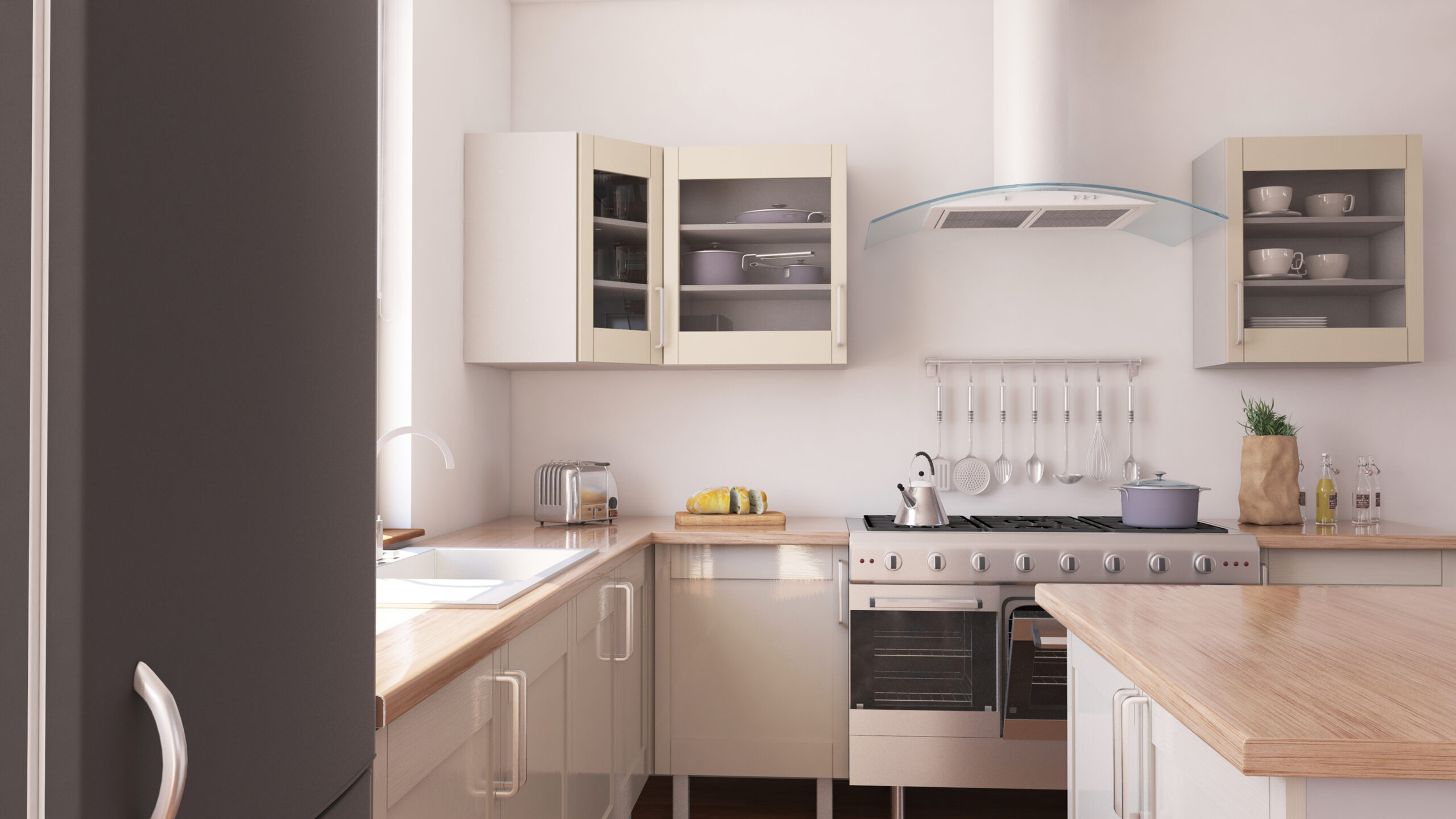Child-friendly kitchen can be created by using key tips and advice that are catered specifically to make it a safe and conducive space. Here are 5 important steps in creating a safe kitchen for children.
Child-Friendly Kitchen #1: Prioritising All Things Safety

A child-friendly home kitchen needs to put the aspect of safety first by creating an accident-free environment. Firstly, attach rounded corners on countertops, tables and cabinets because sharp edges may cause serious injury at lower heights to small children. Install childproof locks on the cabinets for locking up harmful substances such as cleaning products, sharp utensils or dishes that easily break. Consider installing stove guards or induction cooktops which are much safer because they only heat the pan and not the surface of the cooktop — reducing the risk of burning.
Keeping the handles of pots turned in while cooking can help avoid children from accidentally knocking over hot liquids or food. Other safety elements include slip-resistant flooring — materials like cork, rubber or textured vinyl reduce slipping and falling on wet floors. Outlet covers on low-lying electrical outlets protect curious little ones from electrical hazards. Step stools used by children to reach counters or sinks must be sturdy and balanced to avoid tipping over.
@ampquartz I just need a light grey European style cabinet. Now you, dont be sad; get your European style cabinet customised with us! 𝐂𝐨𝐧𝐭𝐚𝐜𝐭 𝐮𝐬! 📞 +6017 732 0149 (Jasmine) +6010 707 7815 (Lekha) +6010 719 7191 (Hema) https://go.wa.link/ampquartz #Europeanstylecabinets #HomeDecorMalaysian #kitchendesign #KitchenCabinets #KitchenCountertops #KabinetDapurJohor #KabinetDapurJB #KabinetDapurUluTiram #KitchenCabinetJohor #AMPQUARTZ
♬ Oh I wasnt sad I just needed – amber | uk + travel
Equally important is with regard to appliances that are dangerous such as blenders or toasters. When not in use, these items should be unplugged and out of the reach of children. When buying appliances, make sure they have child-safety features such as auto-locking doors or buttons that prevent accidental operation. Finally, consider including fire safety such as having a fire extinguisher within easy reach and teaching kids basic kitchen safety from an early age. In putting safety first, you will have a kitchen where children can satisfy their curiosity, learn new things and can help in daily chores with no kind of risk.
Child-Friendly Kitchen #2: Installing Durable Materials

In choosing surfaces for a child-friendly home kitchen, durability and ease of cleaning will be important for both safety and functionality. Materials such as Silestone are a very good option for countertops because they are highly resistant and hygienic. Silestone resists any scratch, staining and heat — it is ideal to withstand inevitable spills, messes and high heat from cooking especially when children are involved. The non-porous and smooth surface reduces the possibility of bacterial spread and generates a better environment for the safe preparation of food.
For example, BWR grade plywood is a type of material that is resistant to moisture and would last very long in home kitchens. Since liquids are involved much of the time in the kitchen, that is an important consideration. A second aspect of durability will be the structural integrity strong enough to withstand repeated opening and closing as would be expected with young children constantly accessing snacks or utensils. These matched up with soft-close hinges provide an additional level of safety where little fingers may get caught.
Another important feature of homes in terms of durability concerns the flooring. Kitchens will be good with anti-slippery materials such as vinyl, cork or rubber. This is because they provide a soft surface that children will feel nice on — reducing the possibility of slipping and falling. Besides, these materials are easily cleaned and can withstand wear and tear at places with heavy traffic.
With the addition of such resistant, easy-to-clean and child-friendly surfaces, the kitchen can counteract daily challenges connected with children and still remain a safe, clean and welcoming environment for all family members.
Child-Friendly Kitchen #3: Creating An Efficient And Organised Space

First of all, design the child-friendly home kitchen to make it well-organised and efficient. Clear organisation makes work in the kitchen easier and helps kids with independence — it is easy for kids to find their way around. Among the effective strategies is labelling the drawers and cabinets when it comes to utensils, snacks or toys. This can be taken to the next level by using colour-coded bins or containers where kids can easily identify where things go. For example, having kid-friendly utensils and plates in lower drawers means they are accessible and the children can start participating in meal preparation and learning basic life skills.
@ampquartz Space tower is the rising star now to home owners out there that love cooking. Not only big space, it also serves good look! as good looking, as your husband 😛 𝐂𝐨𝐧𝐭𝐚𝐜𝐭 𝐮𝐬 𝐟𝐨𝐫 𝐦𝐨𝐫𝐞 𝐝𝐞𝐭𝐚𝐢𝐥𝐬 𝐨𝐤!📞 +6017 732 0149 (Jasmine) +6010 707 7815 (Lekha) +6010 719 7191 (Hema) https://go.wa.link/ampquartz 📍𝐕𝐢𝐬𝐢𝐭 𝐨𝐮𝐫 𝐬𝐡𝐨𝐰𝐫𝐨𝐨𝐦! Address: https://waze.com/ul/hw23bfh9s4 82, Jalan Gaya 1, Taman Gaya, Ulu Tiram, 81800 Johor Bahru 💻 𝐕𝐢𝐬𝐢𝐭 𝐨𝐮𝐫 𝐰𝐞𝐛𝐬𝐢𝐭𝐞! https://www.ampquartz.com/ #fyp #spacetower
♬ original sound – Ampquartz Kitchen Cabinets – AmpQuartz Cabinets
An organised kitchen also enhances the aspect of safety. Keeping hazardous items such as knives or cleaning supplies in locked cabinets or out of reach creates a much safer space for children to explore. Having a specific space for healthy snacks that are accessible to the children will help them learn to eat healthier. Using clear, open shelving or containers helps kids quickly identify their options without needing assistance from an adult.
Functionality also plays a very important role in making the kitchen child-friendly. The presence of a step stool will allow the child to reach the countertops or the sink safely and make them feel part of the daily kitchen activities. A well-organised kitchen will also ensure everything has its place and at the same time reduce clutter — making it a more relaxed and pleasant area for the family. By combining organisation and functionality, parents can create a kitchen not only encouraging of the child's independence but also safer and more welcoming to all.
Child-Friendly Kitchen #4: Consider Accessibility For Storage

Accessible storage can make the home kitchen very child-friendly, be it for promoting independence or ensuring safety. A properly designed lower-level cabinet and drawer encourage children to be actively involved in day-to-day activities such as setting the table or fetching their own snacks. On the other hand, if spaces are dedicated to child-friendly height, kids can have easy access to dish ware, utensils and healthy snacks easily without the help of any grown-ups. This not only boosts independence but also eliminates the risk of an accident while reaching or climbing for something.
Soft-close drawers and bins reduce the chances of finger injuries and create smoother operation. Labelling storage areas with simple words or pictures assists in organisation both by kids and adults — kids can quickly determine where things go. Utilising colour-coded containers or bins may add a more playful touch to organisation while maintaining types of items — catering or toys and food items.
Another handy inclusion is the addition of a strong step-stool. This enables the child to access countertops and higher storage safely for whatever needs doing which further empowers the child in aiding or performing simple meal preparation or cleaning activities. The step stool together with non-slip material used becomes a safe and useful aspect in the kitchen.
Accessible storage in a child-friendly kitchen essentially enables children to make daily activities manageable while allowing for a much safer and well-organised atmosphere. On that note, well thought-out planning may allow for better storage solutions to find a balance between functionality and safety and give the child a sense of inclusion — allowing them to be part of the kitchen while minimising all kinds of risks.
Child-Friendly Kitchen #5: Focus On Hygiene And Cleanliness

A hygienic kitchen is important for safety and cleanliness — adding to an environment suitable for children. This would be achieved by the usage of easy-to-clean and non -porous materials for countertops. Silestone does not stain and supports neither bacteria nor mould — making it a very hygienic surface on which to prepare food. Other hygienic options would include cabinets made from BWR plywood which resists moisture and the growth of mould and ensures a clean and durable storage area.
Hands-free appliances such as touch-less faucets or trash cans go a long way in reducing the transmission of germs. This is especially so for children who are at an age where they do not understand hygiene practices well. An installed step stool encourages kids to wash their hands frequently — enabling them to form good habits early while maintaining hygiene.
@ampquartz This accessory is very beneficial for vertically challenged home owner in terms of.. everything! 𝐂𝐨𝐧𝐭𝐚𝐜𝐭 𝐮𝐬 𝐟𝐨𝐫 𝐦𝐨𝐫𝐞 𝐝𝐞𝐭𝐚𝐢𝐥𝐬 𝐨𝐤!📞 +6017 732 0149 (Jasmine) +6010 707 7815 (Lekha) +6010 719 7191 (Hema) https://go.wa.link/ampquartz 📍𝐕𝐢𝐬𝐢𝐭 𝐨𝐮𝐫 𝐬𝐡𝐨𝐰𝐫𝐨𝐨𝐦! Address: https://waze.com/ul/hw23bfh9s4 82, Jalan Gaya 1, Taman Gaya, Ulu Tiram, 81800 Johor Bahru 💻 𝐕𝐢𝐬𝐢𝐭 𝐨𝐮𝐫 𝐰𝐞𝐛𝐬𝐢𝐭𝐞! https://www.ampquartz.com/ #fyp #dishrack
♬ original sound – Ampquartz Kitchen Cabinets – AmpQuartz Cabinets
Organising the kitchen for cleanliness also helps. It keeps clutter at bay and reduces contamination risks by having specific places for child-friendly utensils, snacks and toys. Colour-coded bins or containers for different items make organisation easier for kids to help with, further maintaining cleanliness in the kitchen. Ventilation is also very important in the kitchen for its upkeep as hygienic. Proper ventilation reduces the humidity level and because of this, mould and mildew can be avoided especially if children will be present in the place.
Inclusion of non-toxic, eco-friendly cleaning products can also be another sure way of giving your toddlers a safe and hygienic environment and not exposing them to certain harsh chemicals on many occasions while keeping surfaces clean. By emphasising these hygienic features, the child-friendly kitchen is a place of safety, health and cleanliness — a haven to be shared by all family members.





